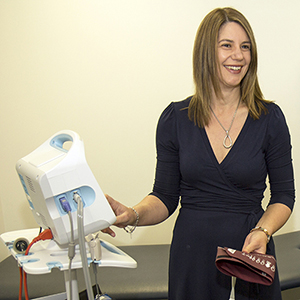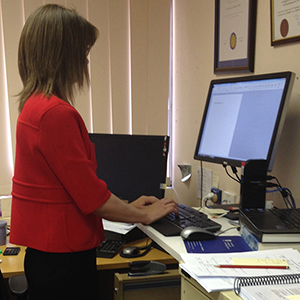Sitting the new smoking Dr Coralie English gets to the bottom of the matter
Throughout her career Dr Coralie English has explored the direct health effects of sedentary lifestyles on stroke patients. Through a series of Stroke Foundation grants she has been able to progress her research and publish in journals such as the International Journal of Stroke, Topics in Stroke Rehabilitation and Physical Therapy. Now, she leads a team of researchers at University of Newcastle and Hunter Medical Research Institute focused on research into physical activity and fitness training for people after stroke and TIA.
A key area of focus for Dr English is the impact of sitting. Coralie and her team are investigating if stroke survivors who sit for long periods throughout the day could improve their health simply by performing short but frequent bouts of light physical activity.
Sedentary behaviour is a primary contributor to the onset of a number of chronic diseases and secondary strokes.
“We have some exciting work underway and in development that will lead to greater understanding of the dose-response relationship between physical activity, fitness training and health after stroke as well as effective ways of supporting and enabling people after stroke to exercise,’’ Dr English said.
“I’d like to eventually be able to say that if you can’t walk independently, if you can at least stand up x amount every x minutes, you will be healthier and reduce your risk of having another stroke.”
Dr English chatted to Stroke Foundation about her work and what we can all do to reduce our risk of stroke.

Tell us a little bit about your research BUST-Stroke?
As a physio I have always been interested in how movement and exercise can improve recovery and well-being after stroke. As we started to learn more about the negative impact of sedentary behaviour on all of us, in particular long periods of sitting time during the day on health, and the potential for small bursts of activity to have a positive difference, I became interested in this.
We know that exercise that raises the heart rate (‘huffing and puffing’ type exercise) is really important and a powerful positive effect on health – but it can be very hard to achieve for people after stroke, particular those who have difficulty walking. What if just getting off the couch and having a short wander around the house at regular intervals could help keep people healthy? That was the inspiration and idea behind BUST-Stroke.
In a nutshell, BUST-Stroke is about understanding the effects that long periods of sitting time has on health of people after stroke – particular on cardiovascular disease risk factors such as blood pressure and blood glucose and insulin levels. In a study that is first of its kind in stroke, volunteer participants have completed 3 separate testing days or ‘experimental conditions’, in random order.
For each condition day they came in to the clinical trials unit at HMRI from 7.30am to 4pm. During this time we took regular (30-60 min) measures of blood (via an intravenous cannula inserted at the beginning of the day) and blood pressure.
The three conditions were:
1. Sitting uninterrupted (we did allow toilet breaks of course!),
2. Sitting with 3-min active standing breaks every 30 mins (including mini-squats, marching on the spot and toe raises) and
3. Sitting with 3-min walking breaks (comfortable pace) every 30 mins. Our participants ranged from people with no difficulty walking to some who walked quite slowly and with difficulty. We are hoping to show that short, frequent breaks of low intensity (‘easy’) activity has a positive effect on health – but we don’t know the answers yet.
What are some of the initial findings?
We are currently in the process of analysing the some 720 blood samples we collected during the trial, I don’t have any final results to tell you about right now. We are hoping to be able to present them later in the year. But there were some interesting and important anecdotal findings.
Firstly, this sort of laboratory based trial is possible and feasible after stroke and more importantly safe.
Secondly, participants reported the day of sitting uninterrupted was the hardest to complete – we did offer magazines, movies and scintillating conversation by our research team to keep them occupied. For some people, standing up or walking at a comfortable pace for three-minutes every 30 -minutes was very difficult to achieve. For a few of our participants this represented a lot more activity than they would do on any day at home and they found it quite difficult. For others it was much easier.
Once we have analysed these results, and depending on what we find, the next steps are to understand just how much less sitting – or more moving – people after stroke need to do each day to see meaningful benefit.
Why is exploring how a sedentary lifestyle and its long term effects a passion for you?
I am passionate about finding ways for people how have had a stroke to live healthy lives. Physical activity, whether that be exercise or just sitting less and moving a bit more, has the potential to do this.
Exercise and activity can be seen as a type of ‘poly-pill’ it has positive effects on a range of things, not only on a range of physiological markers (blood pressure, heart rate, blood glucose, muscle strength etc) cardiovascular and stroke risk factors, but also mood, cognition and potentially post-stroke fatigue.
My team’s work in sitting time, exercise and fitness training after stroke is seeking to understand more about how much, for whom and when is best. I am passionate about developing a solid scientific evidence basis for what we do as therapists and what we are advising our clients or patients to do to on a daily basis.
We hear a lot about how harmful sitting for long periods can be. What advice do you have for people that work in an office?
There is no doubt that sitting less and moving more is good for your health in many ways, and probably also increases your productivity at work. We now also know that the long-term effects of long periods of sitting are much more pronounced for people who also don’t get enough ‘huffing and puffing’ exercise.
If you are going to the gym or a run for at least 30-minutes most days of the week, long periods of sitting probably aren’t as bad for you compared to if you never exercise. But how many of us really manage this on a regular basis?
My advice is to find ways to incorporate standing and walking breaks into your day. A standing desk can help, but other things like standing up to answer the phone, standing up to talk to your colleague when they pop their head into the office, moving the printer away so you have to get up and move can also help.
Small changes in your behaviours at work can make a difference

Chronic disease is having a greater and greater impact on people of working age. Is there something leaders within organisations/HR departments should be doing to encourage people to get up and about more?
Encouraging standing meetings and walking meetings can help, as can social activities with an exercise focus. Providing changing rooms and places for bike storage is another really important way to encourage people to walk or bike to work. But ultimately looking after one’s health is an individual responsibility.
Sitting has been described as the ‘new smoking’ do you think that is a fair analogy?
It makes for a good opening slide at a conference talk – I have used it a few times! It may be a bit of an overstatement, but does serve to highlight an important issue.
What do you do yourself to avoid being sedentary?
Like everyone, probably not enough. I do try and get out for a run or walk most mornings. I also have a standing desk at work and try and get up and move as much as I can during the day.
You will most often find me standing up the back or off to the side at conferences and I insist (for their own good) that the audience gives me a standing ovation at any talk I do!
